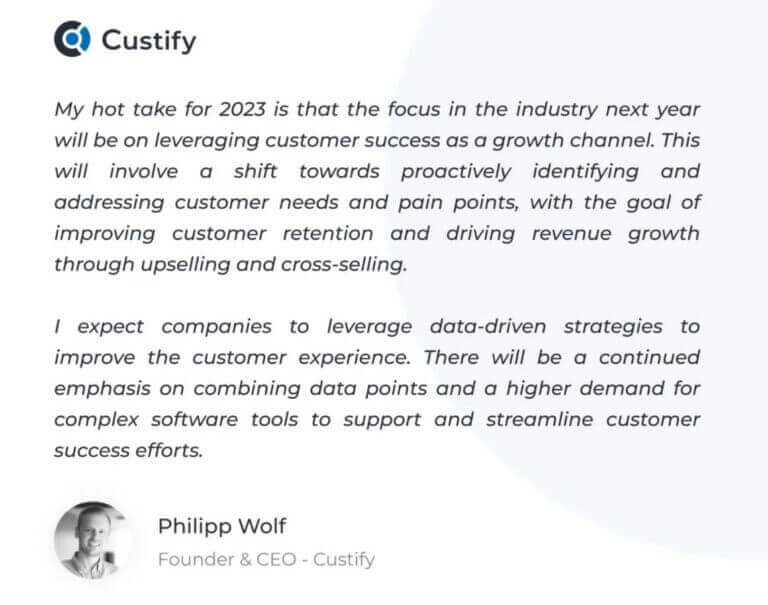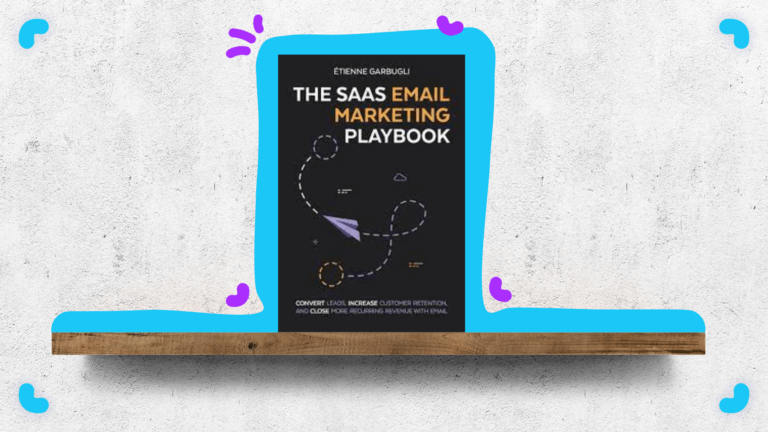Philip Wolf is the Founder & CEO of Custify, a customer success platform for SaaS companies. Custify aims to take the pain out of customer success management and allows teams to spend time with clients rather than organizing CRM data.
We recently hosted Philipp on The Unlocking Growth Show to share his ultimate Customer Success Playbook;
3 ways to use Customer Success as a growth channel, not a cost center.
Philip, tell us what your company does and why?
“So customer success is our daily bread and butter. The thing is that the majority of revenue in a mature sized company, typically comes from existing customers. Probably as much as 80% or even 90% of all revenue. ” ~ Philipp Wolf, CEO & CoFounder of Custify
This means you can’t afford to lose a customer. And the flip side is that if a customer stays, the’re more likely to expand and use other products.
I started Custify after I saw an opportunity after seeing how companies spend big money getting new clients without a systematic approach making sure these clients are also successful, and stay!
So the question was how can customer success teams basically foster client relationships, make sure those customers stay?
That’s how we started. Now Custify enables your customer success team to deliver a best-in-class experience to make sure that customers stay.
Who needs your Customer Success Playbook?
In other words, who is this mostly going to help and what kind of impact can they expect from some of your learnings?
I would say it depends a lot on the stage of your company.
In smaller companies, we see a lot of the founding teams still involved in customer success activity as they are involved in almost everything in the company from sales to product. In larger organizations, there’s sometimes a Customer Success (CS) leader.
In general it’s those in the company that take care of existing customers. Their role is essentially in onboarding or in making sure the customer adopts the product.
They may reach out when they are very successful for case studies and testimonials. They reach out if they’re not so successful, they make sure they renew.
I would say however that every CEO and Founder needs to understand the principles in order to harness customer success as a growth channel.
So what is YOUR Customer Success Playbook?
I think the first thing to understand is that customer success is a growth channel and NOT a cost centre. Just shifting that mindset is very important. Today I want to share 3 ways to use Customer Success as a growth channel, not a cost center.
1. The first very obvious one is lowering churn
If you think about your journey as a startup, in the beginning, you don’t care more about product market fit. At some point in time, you have customers, and these customers say they don’t want to continue with you, and that’s painful because you did a lot of effort to acquire them. Welcome to customer churn.
You put in a huge amount of effort to client onboarding and adopting the product and then they leave.
So that is obviously the main purpose that most people implement a customer success team or customer success processes in the first place.
Lowering churn has a very obvious and dramatic impact on business revenue and sustainability.
Now, this is done in various different ways. If we talk about the customer success playbook itself you need to make sure you understand churn in relation to your business.
- What does your churn look like in the company?
- What’s the kind of churn that your company is facing? Because there are several churns that require different approaches.
For example, there’s churn that you can do nothing about but then there’s the churn that you can do something about it.
For example, the problem that the customers don’t perceive enough value, that’s the number one reason why people leave in the end.
How to ensure customers get value?
You can use a tool like Custify or you can just simply make sure that you get in touch with your customers frequently and ask them questions. If you have 10 customers for example, you could have weekly or monthly meetings with them in the very early stage of your company to really understand their needs and pain points.Ask the right questions about do they get the value.
So when we talk about churn, it’s all about identifying the kinds of churns that you can do something about. And I would say the one around value is the most important one.
To help customers gain value, think what can I do to change that situation?
- Can I have a call?
- Can I explain them?
- Can I help them use the product better?
- Can I send them educational content videos?
- Can I lead them to either a block article or to best practices, etc
The list is long, and it means a lot how high-touch you are in your business in order to do that.
Ultimately if a company has a recurring impact on your product or service, they’re most likely not going to churn.
2. The second step is to expand revenue through value
The more you think about the growth of the company, the more modules you will add to your product to offer customers more value.
Let’s think about the example of negative churn; the aspirational state for any subscription business where a business’s monthly revenue from existing customers is greater than the revenue lost from cancellations and downgrades.
Typically this happens for current customers who expand by upgrading or purchasing additional services or products.
The customer success team’s role here is essential because it isn’t about the CS team selling. It’s more of a recommendation kind of engine that you build because you are the customer success manager and understand your customers.
You spend time with customers, you know how the customers is using the product. They told you just now what kind of value they get from your product, and based on this, you already see that this other thing that we have only available in the other plan would actually really help them.
It’s not about selling them something that they use or don’t need. It’s about mentioning it because the customer would gain added value.
Here you’d need to think about a relevant process. Nail down the potential moments of such upgrades and upstairs, when can they happen?
- What’s your way of upselling?
- Is it the number of users?
- Is it a plan that they can change from small to big?
- Or is it additional modules they can buy? What are those?
Then find out in the conversations or in your touchpoints with your customers when it’s appropriate to mention. It’s VERY important that it isn’t a sales pitch!
It’s more like a, you really help the customer to be even more successful. And it’s a win-win situation if done right, meaning you will get more revenue and the customer will get more values. That’s the best-case scenario.
Coach customer success managers and officers to really frame it as a recommendation using data-driven touchpoints and the conversations they have, rather than pitch it as a sale.

3. And the third is creating customers as advocates
If you build really great relationships with customers and add value to their lives they’re going to recommend you further. It’s that simple.
They’re going to speak about you, they’re going to change jobs, and they’re going to want to work with you again.
As an example, there was a CS Manager using Custify that changed jobs. And in the new company, she was basically put there as a leader of the team. She immediately says, “I don’t want to work with anyone else than Custify so I can also be successful here."
She didn’t want similar software. She wanted Custify. She would do everything to promote the company.
So she was an advocate of the company and the tool.
This is different from someone who likes to use your software. An advocate will actively promote you. They will open up their network. They will ensure they take you with if they switch jobs.
If you can create this kind of customer, that is, of course, extremely helpful when you think about growth channels, right?
It gets you, new customers, opens up the network, and ensures brand awareness. It’s true what they say, the best form of marketing is word of mouth, and there’s no better way to spread the word than from customers themselves.
Think about the difference between someone else introducing your product who has a history of using the product versus anyone that you have to approach cold or anyone that signs up to your website has never heard of you and compares you to 10 other tools or products.
Think about how more likely you are to buy something when someone recommends it to you versus when you know nothing about a product. Even if it costs more you probably won’t mind.
You buy it because a friend referred it to you. And it’s just so much to us that you don’t need to look even for alternatives. There might be a similar product for a hundred bucks cheaper, but you don’t go for it. You go for this other one because it was recommended.
So that’s why these customer advocates are extremely powerful.
And that’s not just up to the customer success team. It’s up to the whole team, and it’s about the customer experience across the board.
It’s how you are being perceived as a company overall over time.
Have you managed to make these customers really successful and listen to them and have built a relationship?
That’s what it’s in the end about. Obviously, you’re only going to create a customer advocate if they love your product. So that’s where you need to start to create a product, and a team, that people love.

But what are some ways a company can facilitate its customers becoming an advocate a little bit easier?
The product must, of course, be there, but following that, it’s about a relationship with the customer. So knowing when to talk to and who to talk to, and why to talk to them.
This is really about living the purpose of the organization in every way and the day-to-day engagement with customers.
It’s definitely not about waiting until the customer reaches out to the support department, although perhaps if you look through the emails that the customer sends or the support tickets that they create, maybe there’s some patterns.
But don’t let such things become reactive.
I had a terrible experience recently, for example, with a German airline. So I’m a very good paying customer of theirs, and I wasn’t very well treated in multiple cases.
It wasn’t someone’s fault, but overall the experience was terrible. So I will not do it again. I will go somewhere else.
It’s that kind of experience you want to avoid.
So you want to get these patterns and you want to see if there are areas where the customer reached out to you because they struggled. And then proactively, you reach out to connect with them.
For example, “Hey, I understand that you struggled, so I talked to the product team…and this is how we’re fixing it. I’m giving this the highest priority. I know it’s a problem for you.”
The perception of your customer is instantly okay; someone really cares. It might not be great right now, but I have this person who is there to help.
Obviously, it starts with the product, but every other single touchpoint, even if it’s not in person, but the interaction it has with your support team through chats and so on counts.
As long as they feel like, hey, they really care about solving my problem, that’s what’s going to move the needle.
So I think if you use those 3 entry points as your customer success playbook, you’ll soon find that customer Success becomes a growth channel in your business, not just a cost center.
Want to create your own Customer Success Playbook in your organization?







